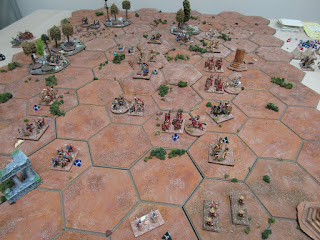The Cisalpine Gauls (those living south of the Alps) had sacked Rome in 390 BC and fought intermittently with Rome for the next 150 years. After a series of defeats early in the Third century BC, the Gauls remained quiet for 50 years. Then in 232 the Romans began settling on captured Gallic lands.
This roused the barbarians to prepare another invasion. This time, the Cisalpine Gauls were joined by their kinsmen from across the Alps, the fierce Gaesatae under their Kings Aneroestes and Concolitanus. In 225 BC a force of 70,000 Gauls descended on Etruria and overran the country looting and pillaging. When they reached Clusium, a city only three days’ journey from Rome, a Roman army led by a praetor appeared on their heels forcing them to turn back and confront it.
The two armies camped for the night in close proximity. The Gauls kept their campfires burning, but withdrew their infantry, leaving only their cavalry behind. The horsemen had orders that when the enemy approached, they were to retire toward Faesulae and their infantry, which lay in ambush. At daybreak, the Romans, seeing the cavalry alone and thinking the Gauls had taken to flight, followed the cavalry with all speed.
On their approach the Gauls sprang from ambush and attacked them. A stubborn conflict took place, but finally the numbers and courage of the Gauls prevailed. The surviving Romans retreated to a hill, while the Gauls set up a loose blockade. These fugitives would all have been lost, but the consul Aemilius Paullus arrived with a relief army that night. The Gallic kings chose to retreat with their booty rather than fight another battle. They broke camp before daybreak and retreated along the seacoast through Etruria.
The stage is set. The battle lines are drawn and you are in command. The rest is history.
War Council
Roman Army
• Leader: Two Roman Praetors
• 5 Command Cards
Victory
6 Banners
Special Rules
When a Roman
unit occupies a Gallic camp hex, it is removed at the Start of the Roman
player’s turn. When all three camp hexes are removed, the Roman player
gains one Victory Banner.
A very pleasant scenario, which I played a total of three times. First time around, with my friends Arnaud and Pierre; the Romans triumphed 6-2 as I remember.
The other two times I played solo, using all my house rules. The Romans won the first battle 6-1.
I then changed tactics for the Gauls, seeking to have them occupy the hilly area as soon as possible; when the Romans are sitting on it, it is hard for the Celts to find targets. The opposite turned out to be true, giving more time for the Gallic warbands to get into the fight. That gave a much closer game, although still a Roman win 6-4. The Gallic warbands made good use of two "Double Time" cards, but neither charge turned out to have a great deal of momentum, which probably lost them the battle.
 |
| 3rd play. The hill was taken by a "Move-Fire-Move" card |
Great stuff, and makes me want to fight more standalone Command & Colors battles.


Et pour les feignants dans mon genre, y a pas de traduction pour suivre ??
RépondreSupprimerJe suis trop feignant moi aussi ; ) Mais j'essaie d'alterner, au moins, entre anglais et français...Merci pour ta visite !
Supprimer